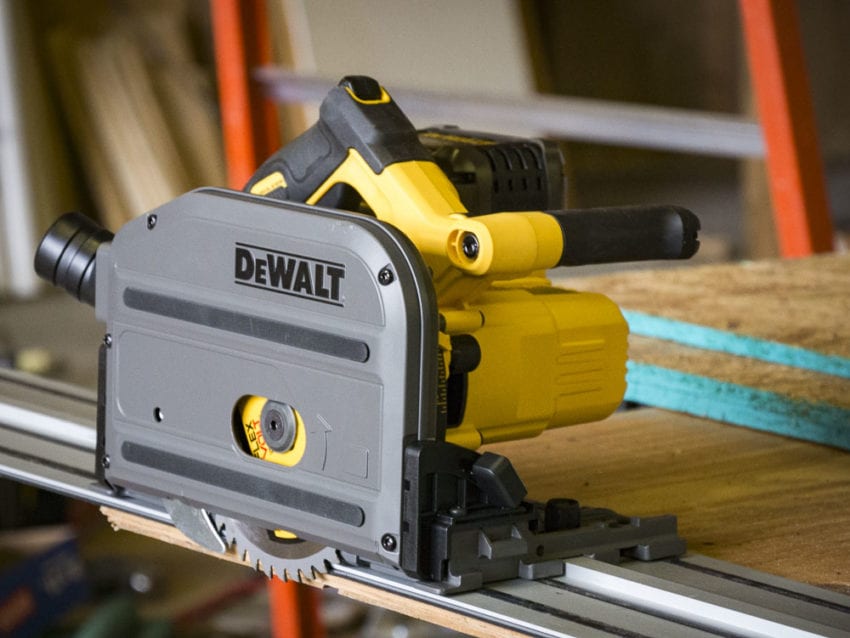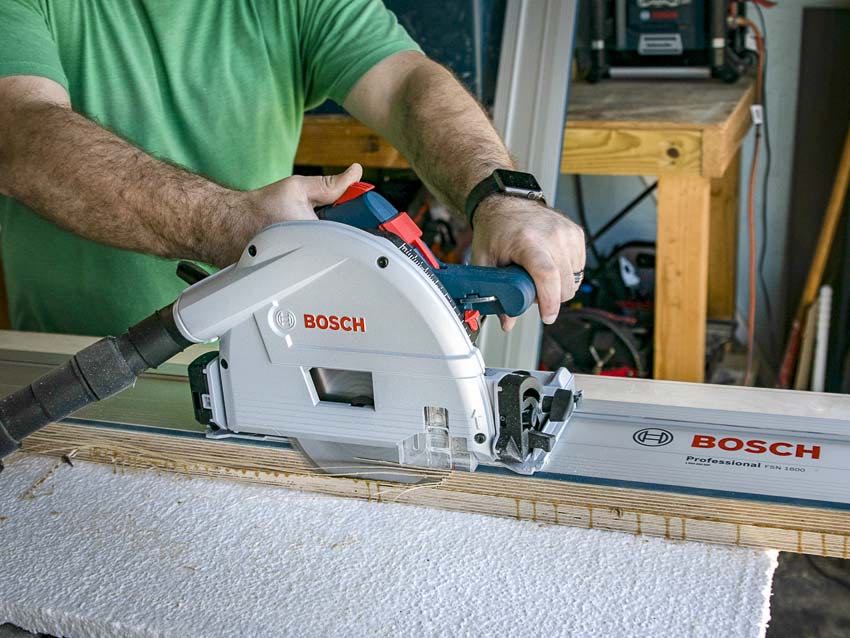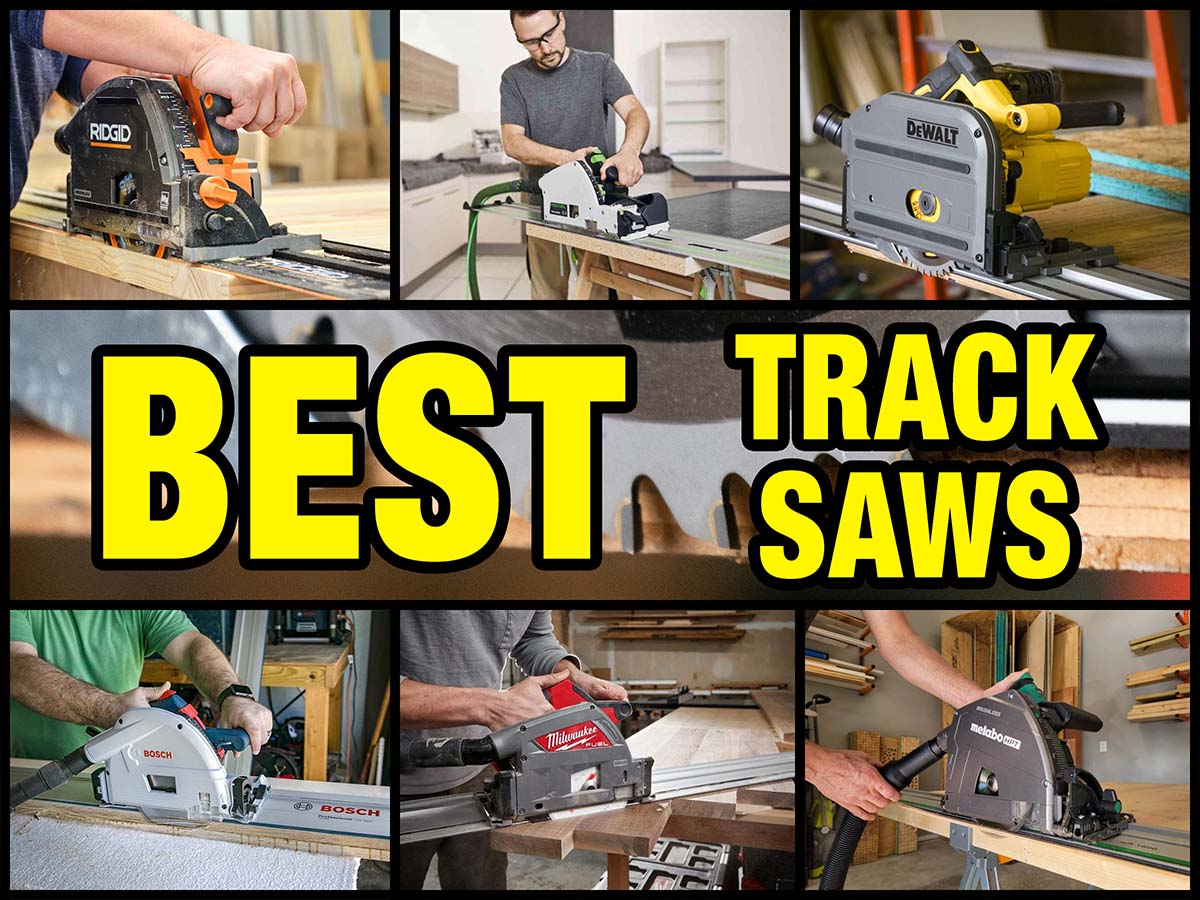It’s hard to beat a quality track saw when you’re making long cuts that require precision. The landscape of what’s available sure has changed since I first started at Pro Tool Reviews more than a decade ago. Today, the best track saws are more likely powered by a battery than an outlet, though there are still plenty of excellent corded models to choose from.
In this article, I’ll share which models are making the greatest impact, along with some tips on what to look for while you’re shopping.
Best Track Saws of 2025
- Festool Scoring Track Saw TSV 60 K
↓ Jump to this Saw - Milwaukee M18 Fuel Plunge Cut Track Saw 2831
↓ Jump to this Saw - Makita 40V XGT Plunge Cut Track Saw GPS01
↓ Jump to this Saw - Metabo HPT 36V Track Saw C3606DPAM
↓ Jump to this Saw - DeWalt 60V Max Track Saw DCS520
↓ Jump to this Saw - Ridgid 18V Brushless Track Saw R48630
↓ Jump to this Saw - Bosch Track Saw GKT13-225L
↓ Jump to this Saw - Ryobi 18V One+ HP Brushless Track Saw PTS01K
↓ Jump to this Saw
Festool Scoring Track Saw TSV 60 K

- Motor: 13A, 1500W brushless
- Blade Diameter: 6 5/8 in
- Blade Speed: 3000 – 6800 RPM
- Max Cutting Depth at 90°: 2 9/16 in
- Max Cutting Depth at 45°: 1 49/64 in
- Dust Port: 1 1/16 or 1 7/16
- Price: $999 – $1175
- Warranty: 3 years
Noteworthy Features
- Diamond Scoring Blade: Scores material ahead of the primary blade to deliver splinter-free cuts
- KickbackStop: Reduces the risk of injury and damage to material in kickback incidents
- Blade Control: Scoring blades can be turned on or off and has a depth adjustment
- Micro Depth ADjustment: Dial in the perfect depth for your cut
Pros
- Brushless motor (unusual for a corded model)
- Variable speed
- Kickback control
- Outstanding cut quality
- High-contrast depth markings
- System-focused design
- Comes in a Systainer SYS3 M 437
Cons
- Expensive
- Non-standard blade size
- Non-standard dust port size
If you want the best of the best track saws, you’ll have a hard time beating Festool. Among several excellent models, the TSV 60 K offers the cleanest cuts thanks to a scoring blade that travels in front of the main blade.
Festool’s system-focused mentality toward product development means there are some oddities compared to other models, though. The most obvious ones are that the blade and vacuum hose sizes are different. However, that’s to encourage you to stay within the system of accessories and dust collectors so you get the best possible performance from your saw.
This is the most expensive saw on our list, but if you’re looking for the best precision and cut quality, Festool’s TSV 60 K is where it’s at.
Milwaukee M18 Fuel Plunge Cut Track Saw 2831

- Motor: 18V Brushless
- Blade Diameter: 6 1/2 in
- Blade Speed: 2500 – 5600 RPM
- Max Cutting Depth at 90°: 2 1/4 in
- Max Cutting Depth at 45°: 1 5/8 in
- Dust Port: 1 7/8 in
- Price: $429 bare, $689 kit
- Warranty: 5 years
Noteworthy Features
- Micro Depth Adjustment: Dial in the perfect depth for your cut
Pros
- Brushless motor
- Variable speed
- High-contrast depth markings
- Bevel stops at 22.5° and 45°
- Comes in a Packout XL Tool Box
- Part of the extensive M18 RedLithium battery system
Cons
- Bevel cuts are slightly off the track edge
Milwaukee’s M18 Fuel Track Saw is a solid Pro-grade tool that doesn’t skimp on performance and is super-smooth on the plunge. While it doesn’t have a ton of unique features, it is very well-rounded, especially considering it’s a first-generation model.
Note that the blade doesn’t perfectly line up with the track edge on bevel cuts. It’s about 1/32 of an inch off the edge and there’s a “Position A” notch on the shoe to help you line up your cut. If you do a lot of bevel cutting, be sure to consider how that’s going to affect your workflow.
Since its launch, Milwaukee developed VacLink to offer automatic vacuum activation, but it wasn’t ready in time to be on their track saw. While I haven’t heard any rumors yet, adding VacLink and tweaking the bevel cut position might put this one in line for a Gen 2 model somewhere down the road.
Makita 40V XGT Plunge Cut Track Saw GPS01

- Motor: 40V max brushless
- Blade Diameter: 6 1/2 in
- Blade Speed: 2500 – 4900 RPM
- Max Cutting Depth at 90°: 2 3/16 in
- Max Cutting Depth at 45°: 1 9/16 in
- Dust Port: 1 7/16 in
- Price: $459 bare, $669 kit
- Warranty: 3 years
Noteworthy Features
- AWS Capable: Automatically activate AWS-enabled vacuums when you press the trigger (transmitter sold separately)
- Dual Bevel Locks: Creates additional stability for bevel cutting
Pros
- Brushless motor
- Automatic vacuum activation capable
- High-contrast depth markings
- Bevel stops at 22.5° and 45°
- Comes in a stackable interlocking case
- Part of the high-performance 40V max XGT battery system
Cons
- AWS transmitter is not included
Considering Makita has one of the most popular corded track saws that’s been out for a while, it’s no surprise their 40V max XGT model is a winner. It’s a solid, high-performance cutting platform that offers the precision Pros need.
One unique feature is Makita’s AWS automatic vacuum activation system. When you connect the tool to an AWS-enabled vacuum, it automatically turns the suction on when you pull the trigger and shuts it off after a few seconds when you let go. It has the benefits of extending the runtime of your cordless vacuum and reducing the overall noise in your shop or on your jobsite. However, you’ll need to buy the transmitter separately if you want that function.
Metabo HPT 36V Track Saw C3606DPAM

- Motor: 36V brushless
- Blade Diameter: 6 1/2 in
- Blade Speed: 2500 – 5200 RPM
- Max Cutting Depth at 90°: 2 5/8 in
- Max Cutting Depth at 45°: 1 3/4 in
- Dust Port: 1 7/8 in
- Price: $499 kit
- Warranty: Lifetime
Noteworthy Features
- Hybrid Power: Run corded or cordless
- Increased Cutting Depth: Cut up to 2 5/8 inches deep
- Micro Depth Adjustment: Dial in the perfect depth for your cut
Pros
- Brushless motor
- Variable speed
- Greater cutting depth than most track saws
- High-contrast depth markings
- Compatible with Metabo HPT’s AC adapter
- Comes in a stackable case
- Lifetime warranty
- Excellent value
Cons
- A few plastic components may need to be replaced over the long-term
Metabo HPT’s 36V track saw is built on an excellent foundation with confident cutting power and a noticeably smooth plunging action. In addition to its clearly Pro-grade cutting performance and quality, it has a couple of real benefits over its competition.
One is its ability to cut deeper than other 6 1/2 -inch models. Without the track, you can cut up to 2 5/8 inches, or 1 3/4 inches at a 45° bevel.
Then there’s its hybrid power source. You can use either a Metabo HPT 36V battery or their AC adapter. Having both options available is perfect if you do a combination of shop and on-site work.
One other thing worth pointing out is the price tag. For $499, you get the saw with a 4.0Ah battery and charger. Most of the other Pro-grade track saws we recommend are much higher. Plus, Metabo HPT offers a lifetime warranty on the tool.
DeWalt 60V Max Track Saw DCS520

- Motor: 60V max brushless
- Blade Diameter: 6 1/2 in
- Blade Speed: 1750 – 4000 RPM
- Max Cutting Depth at 90°: 2 1/8 in
- Max Cutting Depth at 45°: 1 5/8 in
- Dust Port: 1 1/4 in
- Price: $429 bare, $579 kit
- Warranty: 3 years
Noteworthy Features
- Anti-Kickback Mechanism: Works with the riving knife to prevent kickback
Pros
- Brushless motor
- Variable speed
- Kickback control
Cons
- Forward push to engage the plunge action takes some getting used to
DeWalt had one of the first cordless track saws we reviewed. Using their corded DWS520 as the foundation, there weren’t many surprises in the design, and the 60V Max battery system did a nice job translating similar power.
From a feature standpoint, it’s a pretty standard design, although their is a mechanism that works with the riving knife to cut down kickback risk.
If you’ve used other track saws, you’ll notice a difference in the way the plunge action works. Instead of pulling the D-handle down, you push it forward. DeWalt claims it’s a more ergonomic movement. We don’t have any complaints about models with the standard action, but once you get used to DeWalt’s, it’ll feel normal. It just takes a little time.
Ridgid 18V Brushless Track Saw R48630

- Motor: 18V brushless
- Blade Diameter: 6 1/2 in
- Blade Speed: 5000 RPM
- Max Cutting Depth at 90°: 2 1/4 in
- Max Cutting Depth at 45°: 1 5/8 in
- Dust Port: 1 1/4 or 1 7/8 in
- Price: $349 bare, $598 kit
- Warranty: Lifetime service agreement
Noteworthy Features
- Includes Track: 55 inches of track and a clamp are included with both the bare tool and kit
Pros
- Brushless motor
- High-contrast depth markings
- Bevel stops at 22.5° and 45°
- Includes 55 inches of track and a clamp
- Lifetime service agreement
- Excellent value
Cons
- Single speed
- Depth markings are only 1/8-inch intervals
If you’re looking for a track saw that’s more dialed in for carpentry than fine woodworking, take a good look at Ridgid’s 18V model. Compared to premium track saws, It lacks variable speed and the depth indicators are at 1/8-inch instead of the 1/16-inch we prefer for the greatest accuracy.
The trade-off is a lower price tag. It’s even sweeter because both the bare tool and kit come with 55 inches of track (2 x 27.5 inches) and a clamp to help you get started. Ridgid’s lifetime service agreement is also in play, making this one of the best values available.
Bosch Track Saw GKT13-225L

- Motor: 13A
- Blade Diameter: 6 1/2 in
- Blade Speed: 3600 – 6250 RPM
- Max Cutting Depth at 90°: 2 1/4 in
- Max Cutting Depth at 45°: 1 5/8 in
- Dust Port: 35mm (~1 3/8 in)
- Price: $639
- Warranty: 1 year
Noteworthy Features
- Wide Speed Range: Cut from 3600 to 6250 RPM
Pros
- Variable speed
- High-contrast depth markings
- Comes with an L-Boxx carrying case
Cons
- Forward push to engage the plunge action takes some getting used to
- Short warranty period
Generally, I prefer cordless track saws over corded for the convenience and advanced features, but in Bosch’s case, I still opt for the cord. The cordless model uses a 5 1/2-inch blade, and I prefer the higher capacity of a 6 1/2-inch model.
So, that takes me back to the GKT13-225L we reviewed a few years ago. It’s a strong saw with a nice, wide speed range that can handle any wood species. There aren’t many advanced features, but its confidence under load, precision results, and thoughtful build don’t leave me feeling like I’m missing out on much.
There is one thing to note, though. This has a very similar forward-moving plunge action to DeWalt’s design. Likewise, it takes some time to get used to if you’ve been using other track saws.
By the way, if your needs are primarily carpentry, Bosch has a track-ready cordless 7 1/4-inch circular saw that’s worth considering.
Ryobi 18V One+ HP Brushless Track Saw PTS01K

- Motor: 18V brushless
- Blade Diameter: 6 1/2 in
- Blade Speed: 4300 RPM
- Cutting Depth at 90°: 2 1/8 in
- Cutting Depth at 45°: 1 9/16 in
- Dust Port: 1 1/4 or 1 7/8 in
- Price: $329 bare, $399 kit
- Warranty: 3 years
Noteworthy Features
- Includes Track: 55 inches of track and a clamp are included with both the bare tool and kit
Pros
- Brushless motor
- Includes 55 inches of track
- High-contrast depth markings
- Excellent value
- Part of the extensive 18V One+ battery system
Cons
- Single speed
- Shallower cutting depth than other 6 1/2-inch models
- Some reports of tracks not aligning well
If you’re after a cordless track saw on a budget, Ryobi is the brand to go with. Their value-packed HP Brushless model is under $400 for a kit, including the saw, a battery, a charger, 55 inches of track (2 x 27.5 inches), and a clamp.
It’s not decked out with a ton of bells and whistles, but it does have everything you need to get started, and yielded quality results in our review. However, you need to take your time connecting the tracks for longer cuts to ensure they’re in proper alignment.
For hobbyist woodworkers, it’s a solid supplement to your table saw for breaking down sheet goods into more manageable sizes. It’s also helpful for plenty of home improvement projects, like decking or tackling that built-in bookcase you’ve always wanted.
What to Look for When Buying a Track Saw
Power
For corded track saws, look for at least 12 amps of motor power. Any less than that, and the saw will struggle to cut thicker and harder materials.
If you’re going cordless, get one with a brushless motor. Voltage alone is no longer the mark of how much power the motor has, but a brushless motor paired with an advanced battery will put you in good shape if you’re buying from a reputable brand.
Speed Adjustments
Track saws with a speed adjustment have a big advantage when you’re working with a variety of material densities. You get better cut quality and avoid burning when you cut hardwoods at a slower speed, while higher speeds are better for softwoods.
Blade Size
Most track saws use a 6 1/2-inch blade, and that’s the size I recommend for most people. You’ll get 2+ inches of cutting depth and have the widest selection of blades available.
Track/Rail Considerations
Because not all rail systems are interchangeable, the saw you buy can also determine which brand of rails you need.
You can always use connectors and multiple rails to reach the length you need, but the fewer you have to use, the lower your risk of error.
For example, if you’re frequently ripping sheet goods, a 100-inch track is highly convenient (albeit kind of a pain to store).
Ergonomics
There’s not a ton of variance in the ergonomic design of most track saws. The unique requirement to both plunge and cut straight favor a D-handle design with a longer front pommel than you find on standard circular saws.
Still, there are some slight differences, so try to put your hands on a few models before you buy to see if one feels better than another.
Weight
Don’t put too much stock in looking for an ultra-lightweight track saw. There’s certainly a point where it can be obnoxious, but you actually want a saw with some meat on its bones to help provide stability during your cuts. With a total working weight (saw, blade, and battery), I like a track saw that’s at least 10 pounds.
Value
There are plenty of ways value comes into play, and price is a great place to start. Low prices are attractive, but there are real benefits to moving up in price. There may be some additional features, but a more durable build and greater precision are worth paying more for, especially if this is a tool that’s helping you make a living.
If you’re looking at cordless models, it’s important to consider what other tools work with the same batteries. It’s a little different with a track saw, because you’re in more of a niche than most general contractors. Consider not only how many tools are on the platform, but which ones can make your specific work more convenient.
Warranty comes into play whether you’re going corded or cordless. For Pro-grade tools, most brands offer at least three years of coverage, but you can easily get 5 years or even a lifetime warranty if you shop around. Be sure to take a look at how you make warranty and service claims so you know what to expect when the time comes.
Why You Can Trust Pro Tool Reviews
Ever check out a “review” site and you can’t tell if they actually test products or if they’re just “recommending” the Amazon top sellers? That’s not us. We won’t recommend anything unless we’d actually use it ourselves, and we don’t care who the primary retailer is. It’s all about giving you a legitimate recommendation and our honest opinion of each product.
Since 2008, Pro Tool Reviews has provided in-depth tool reviews, buying guides, how-to articles, and industry news in the construction and lawn care industries. We focus on professionals in the trades and our writers have the skills and experience to know whether a tool or accessory will hold up on the jobsite.
Each year, we bring in and review more than 250 individual products. Additionally, our team will put their hands on hundreds more tools at media events and trade shows throughout the year. If I recommend a track saw, that means I’d use it myself (and perhaps one of us already does!)



